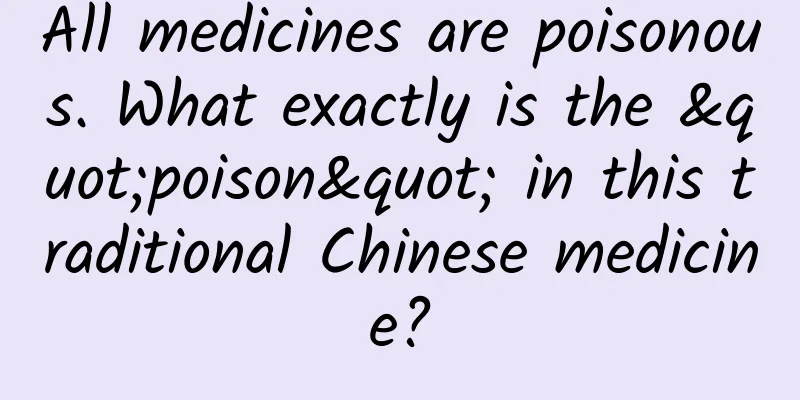All medicines are poisonous. What exactly is the "poison" in this traditional Chinese medicine?

|
As the old saying goes, "All medicines are three-tenths poisonous." Some people think that the "poison" refers to the adverse reactions of Western medicines, and that Chinese medicines have fewer side effects and are mostly "pure natural, safe and non-toxic." Others think that the "poison" refers to the poisonous ingredients in Chinese medicines, such as arsenic and cinnabar. In fact, "all medicines are three-part poison" refers to both Western medicine and Chinese medicine. Chinese medicine is not non-toxic, nor is it safer than Western medicine. The safety of Chinese medicine is also worthy of attention. Today we are going to talk about the "poison" of traditional Chinese medicine~ Understanding the Toxicity of Traditional Chinese Medicine Traditional Chinese medicine has a broad and narrow understanding of the toxicity of Chinese medicine. In their years of production practice, the ancients discovered that some things are harmless to eat regularly, while some things can harm the body but can also cure diseases. Therefore, non-toxic things are regarded as "food", toxic things are regarded as "medicine", and "poison" and "medicine" are collectively referred to as "poison", that is, "poison" is regarded as a general term for all medicines, referring to all medicines that can treat diseases. In the Ming Dynasty, Zhang Jingyue's Lei Jing said: "Generally speaking, anything that can ward off evil and restore health can become poison, so it is said that poison attacks evil." Lei Jing also proposed that "medicine is used to treat diseases, and its ability is due to poison. The so-called poison is due to the bias of smell and taste", which discusses the broad meaning of poison. Broadly speaking, toxicity is to regard the toxicity of a drug as the bias of the drug. In a narrow sense, toxicity refers to the toxicity of the medicinal material or the severity of the adverse reactions. For example, "Suwen Wuchang Zhengda Lun" states: "For highly toxic treatment, six out of ten should be removed; for common toxic treatment, seven out of ten should be removed; for slightly toxic treatment, eight out of ten should be removed; for non-toxic treatment, nine out of ten should be removed. Eat as much grain, meat, fruit and vegetables as possible, but do not overdo it to damage the body." Nowadays, the toxicity of traditional Chinese medicine refers to the adverse effects and damages it has on the human body. Toxicity classification of traditional Chinese medicine Ancient medicine classified Chinese medicine into three categories according to the toxicity: highly toxic, moderately toxic, slightly toxic, and non-toxic. In Shennong's Herbal Classic, the toxicity of Chinese medicine is mainly divided into two categories: "toxic" and "non-toxic". The current Pharmacopoeia of the People's Republic of China uses a three-level toxicity classification method of highly toxic, toxic, and slightly toxic to classify the toxicity of Chinese medicine. This classification method is also the most commonly used classification method at present. There are currently more than 12,800 varieties of traditional Chinese medicine, and poisoning reports have been reported for more than 100 of them, including many highly toxic drugs that are rarely used in clinical practice. Common Chinese medicines that can cause poisoning in clinical practice include: Adenophora australis, Xanthium sibiricum, Melia azedarach bark, Aconite root, Aconitum carmichaelii, Croton tiglium, Pinellia ternata, Pharbitis seed, Strychnos nux vomica, Apricot kernel, Mylabris persica, and Toad, etc. The main causes of Chinese medicine poisoning Different poisoning symptoms are caused by different systems of the human body. The main causes of Chinese medicine poisoning are as follows: One is that the dosage of the medicine is too large, especially for traditional Chinese medicines with high toxicity such as aconite, monkshood, and strychnos nux vomica. Large dosage and long duration of medication can lead to poisoning. Second, accidentally taking counterfeit products can also cause poisoning, such as replacing ginseng with Chinese ginseng, replacing gastrodia elata with unicorn vine, and replacing trumpet creeper with datura truncatum. The third is improper processing, such as taking unprocessed raw aconite and raw monkshood. Fourth, improper decoction and administration methods, such as decocting Aconitum and Aconite for too short a time to completely remove the toxic components of the drugs, or catching a cold after taking the drugs, or eating raw and cold food, causing poisoning. The fifth is improper compatibility, such as compatibility that violates the "Eighteen Antidotes" principle. In addition, there are cases of Chinese medicine poisoning caused by inappropriate medication, self-medication, and medication by nursing mothers. When we fully recognize and understand the toxicity of traditional Chinese medicine and use it rationally in strict accordance with the doctor's orders or instructions, we can not only effectively reduce iatrogenic and drug-induced diseases and avoid toxic events, but also maximize the efficacy of toxic traditional Chinese medicine. Author: Li Yun, Chief Pharmacist, Tianjin Medical University General Hospital Review expert: Li Bin, deputy chief pharmacist of Tianjin Medical University General Hospital |
<<: What category of garbage do plastic bags belong to? Are heated plastic bags toxic?
>>: Why should kitchen waste be thrown away in plastic bags? The harm of plastic bags
Recommend
What will happen to your body if you drink a cup of soy milk every day? Don't drink one of these, it will cause poisoning!
Hello, this is Science Popularization China. We a...
A woman dreamed of cutting a snake into pieces
Everyone often dreams of chopping a snake into pi...
Counterpoint: Global smartphone market revenue to reach approximately $410 billion in 2023, with shipments down 4%
According to the latest report released by market...
What are the side effects of menopause injections?
The menopausal injection is a medicine that is gi...
Can the newly bought azalea be repotted? Under what circumstances does the azalea need to be repotted?
As people's quality of life improves, more an...
What are the symptoms of sexual dysfunction in women
In marriage, communication between two people is ...
What should women with liver and kidney deficiency eat?
Whenever talking about kidney tonification, femal...
What to do if you have vaginal pain? There are methods for daily care
The vagina is a private and sensitive part of wom...
How to choose crabs correctly? Can I drink monk fruit after eating crabs?
Crabs are rich in high-quality protein, minerals,...
How many eggs can a woman release during ovulation?
Generally speaking, women will release one egg du...
Does smoking affect your appearance? It’s true!
Does smoking affect your appearance? You may answ...
"Please help me remove the tumor!" The 88-year-old uncle was determined. This operation made his wish come true.
Can I still have surgery when I am old? This is a...
How to deal with breast pain
I don't know what happened recently but my br...









